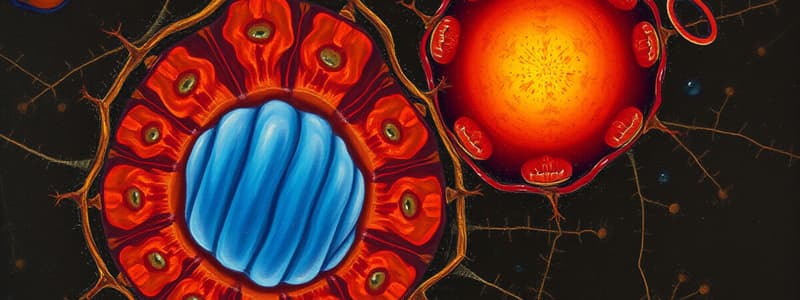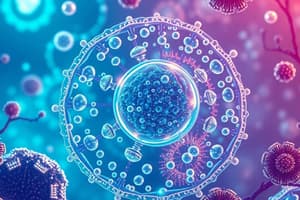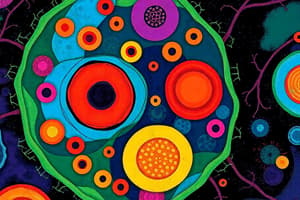Podcast
Questions and Answers
What is the main function of the vacuole?
What is the main function of the vacuole?
- Produces energy
- Synthesizes proteins
- Transports materials
- Stores materials within the cell (correct)
What are chloroplasts?
What are chloroplasts?
Closely stacked, flattened sacs found in plants only.
What is the primary function of ribosomes?
What is the primary function of ribosomes?
Sites of protein synthesis.
What do vesicles do?
What do vesicles do?
What is cytoplasm?
What is cytoplasm?
What role does the nucleus play in a eukaryotic cell?
What role does the nucleus play in a eukaryotic cell?
What does chlorophyll do?
What does chlorophyll do?
What do lysosomes digest?
What do lysosomes digest?
What are small bumps located on portions of the ER?
What are small bumps located on portions of the ER?
What is the function of the cell wall?
What is the function of the cell wall?
What do mitochondria produce?
What do mitochondria produce?
What is the role of the Golgi apparatus?
What is the role of the Golgi apparatus?
What constitutes the cell structure?
What constitutes the cell structure?
What is the ER?
What is the ER?
What surrounds the cell?
What surrounds the cell?
What is the lipid bilayer?
What is the lipid bilayer?
What is the nucleolus?
What is the nucleolus?
What does the cytoskeleton consist of?
What does the cytoskeleton consist of?
What are cilia?
What are cilia?
What is the composition of the cell membrane?
What is the composition of the cell membrane?
What are flagella?
What are flagella?
Flashcards are hidden until you start studying
Study Notes
Cell Organelles Overview
- Vacuoles: Store materials within the cell; provide temporary storage for food, enzymes, and waste products.
- Chloroplasts: Found only in plants; contain chlorophyll that traps sunlight energy and gives plants their green color; consist of closely stacked, flattened sacs.
- Ribosomes: Sites of protein synthesis; small bumps on portions of the endoplasmic reticulum (ER); essential for cellular functions.
- Vesicles: Transport materials within the cell; play a key role in cellular logistics.
- Cytoplasm: The region inside the cell excluding the nucleus; the site for many metabolic processes.
Eukaryotic Organelles
- Nucleus: Organelle that controls cell functions; houses DNA and manages cellular activities in eukaryotes.
- Lysosomes: Digest excess or worn-out cell parts; break down food particles and invading pathogens like viruses or bacteria.
- Mitochondria: Produce usable energy for the cell through ATP synthesis; known as the powerhouse of the cell.
- Golgi Apparatus: Packages proteins for transport out of the cell; modifies, sorts, and ships cellular products.
Additional Structures
- Cell Wall: Firm protective structure in plants, fungi, most bacteria, and some protists; provides shape and support.
- Endoplasmic Reticulum (ER): Site where ribosomes are made; involved in protein and lipid synthesis.
- Cell Membrane: Surrounds the cell; composed of a phospholipid bilayer that supports and regulates what enters or leaves the cell.
- Lipid Bilayer: Provides structural support for the cell; consists of two layers of phospholipids.
- Nucleolus: Located within the nucleus; responsible for the assembly of ribosomes and contains a collection of DNA.
- Cytoskeleton: Composed of hollow tubes; provides structural support and shape to the cell.
- Cilia: Small hair-like structures used for movement or sensing environmental changes.
- Flagella: Longer, whip-like structures that facilitate movement in certain cells.
Studying That Suits You
Use AI to generate personalized quizzes and flashcards to suit your learning preferences.




